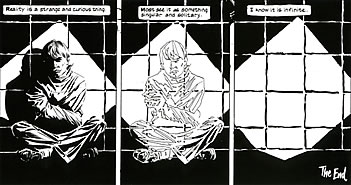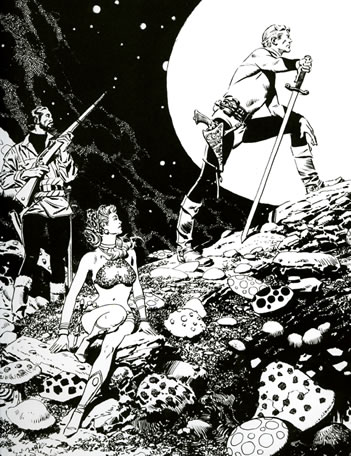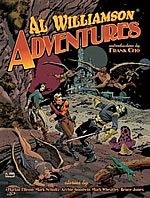Al Williamson:
Vistas Of Other Worlds
"Reality was a matter of perception. Alter perception and new universes were born, endless, infinite, where any reality imagined could actually exist."
These are the thoughts of a man named Strode, a fevered dreamer stifled by the demands of the mundane world. His desire to escape burns so strong in him that he develops the ability to ‘phase’ himself out of reality and travel to the most fantastical alternative dimensions.
Here he is the hero surrounded by space rockets, soaring cities, terrifying reptiles, voluptuous women and outbreaks of those alien toadstools (magic mushrooms, anyone?). Unwilling to return, Strode is finally judged insane and put away. But in the closing frames he ‘phases out’ for one last time and disappears.

Like Strode, comics illustrator Al Williamson has that same rare ability to ‘phase out’, and fortunately for us, Williamson has not yet vanished and still walks among us. Williamson has another rare ability. He can somehow conjure up such convincing vistas of these other worlds, that it seems he must have been there himself. For more than fifty years, his vividly imagined universes have enabled thousands of his readers to ‘phase out’ of the everyday and step into wonder.
‘Phasing out’ is a fantasy a lot of us share. It may explain why the idea of an ordinary earthling finding themselves transported to another, more vivid and exciting world than ours is at the core of so much science fiction and comics. It’s there in Edgar Rice Burroughs’ John Carter Of Mars through to the Silver Age’s Adam Strange and his ‘zeta beam’, and Richard Corben’s Den graphic novels. It was also behind Alex Raymond‘s 1934 newspaper strip hero Flash Gordon, originally a polo player and Yale graduate who becomes the savior of the planet Mongo.

Flash Gordon made a lasting childhood impression on Al Williamson. As an American boy, he was already growing up in another world, the South American city of Bogota, Columbia. His fascination with Flash Gordon started when he was swept away by the 1940 movie serial starring Buster Crabbe. As he told S.C. Ringgenberg in Comic Book Marketplace #51, ‘‘I was immediately taken with it. It took over my life." Drawing comics became his passion and his career and Williamson drew Flash Gordon himself on several occasions. For this new compilation of comics from 1978 to today Williamson provides a dynamic image of the hero for the front cover, while the endpapers present his stunning Flash Gordon tableau from the 1980 National Cartoonists’ Society portfolio.
It was another dreamer, the late Archie Goodwin, who wrote Out Of Phase. Appropriately, he ran it in February 1986 in the final issue of Marvel’s answer to Heavy Metal magazine, Epic Illustrated. It’s one of five of the best recent science fiction stories rendered by Williamson which are compiled into this handsomely produced 100-page hardcover. Goodwin provides another, Relic, from the December 1984 Epic Illustrated, featuring Al’s bravura planetscapes and dedicated to his mentor, the great Roy G. Krenkel. The initials ‘RGK’ also pop up in Out Of Phase on a pair of retro-styled rocket ships.
Bruce Jones scripts The Few And The Far, originally in the first 1982 issue of Alien Worlds from Pacific Comics. Williamson was in his element in Jones’ homage to EC science fiction. The earliest piece here is Williamson’s 1978 full colour adaptation of Harlan Ellison‘s automobile nightmare Along The Scenic Route. The reproduction, coloured inks and white areas are so much clearer here than its original printing in Ariel Book 3. The most recent reprint is One Last Job, written by Mark Schultz for Dark Horse Presents #120 as a touching tribute to Williamson’s fellow EC genius, Wally Wood.
These SF yarns interweave between the six chapters of Williamson and Bruce Jones’ Cliff Hanger, their affectionate tribute to those thrill-a-minute Saturday morning adventure serials. Movie-style opening and closing credits with blackout-style panel borders reinforce the cinematic effect. These first appeared in the color Somerset Holmes comic books from Pacific in 1983-4. Like all the other classics here, they benefit enormously from the crystal clear reproduction of the finest details, rich, deep blacks, bright white, high quality paper and large 9 x 12 inch format. It’s like seeing some of them for the first time, re-mastered in crisp black and white. You really can ‘phase out’ and lose yourself inside these panels.

And there’s a bonus: a brand new, unpublished 11-page story Tracker. It’s written in the spirit of Williamson’s realistic tough-guy detective work on Secret Agent X-9 by comics creator Mark Wheatley, the book’s editor and Insight Studios Group co-publisher. Mark told me, "I’ve been a fan of Al’s since I was a kid and this book project has been a dream come true for me. To work with Al, to actually write a story for him, it just blows my child-fan mind at the reality." It’s a clever, topical mystery with all the polish and panache Williamson is revered for. Mark has had some fun too, name-dropping such masters as Crane, Coll, Foster, Raymond as the characters. As a result, on the very first page, Mark gets away with Tracker alias Michael Caniff exclaiming, ‘Raymond, you’re a big fat pain!’. I spotted only one minor glitch: pages 3 and 4 have been printed in reverse order.
It would be hard to conceive of a finer showcase for Williamson’s mature comics artistry than this labor of love. Frank Cho of Liberty Meadows supplies a very personal introduction and the limited edition comes with an extra color signed plate of two lizards dressed like Flash Gordon toasting two Williamson babes.
While I was immersing myself in this volume, I kept spotting Williamson’s likenesses. He has always regularly used his own face and figure as references for his male leads. It’s as if by modelling and posing, he is make-believing he is the hero. He is no longer at the drawing board but there inside the panel. What a perfect way to ‘phase’ yourself out - by being able to draw yourself into ‘new universes…endless, infinite, where any reality imagined could actually exist’. Thank you, Al, for taking us all along with you.

Update: November 7th 2021:
A nice surprise today, I have been emailed by Ed King, who worked for Al Williamson as his letterer, and sometimes also as one of his models:
“I just ran across your story about Al, in particular your piece about the story ‘Out of Phase’ that Al drew for the final issue of Epic Illustrated. I worked in comics as a letterer in the early 1980s, mostly for the work that Al Williamson did at that time. He saw my lettering on a local restaurant menu and contacted me to do the lettering on the Star Wars strip. It was my ‘big break’. It’s well-known that Al often used his friends as models (as well as himself) and since I was usually hanging around the studio I regularly got pressed into extra service as a model, sometimes when Al needed a particular pose of a hand or foot, or a particular action, and sometimes in a starring role. Such was the case with ‘Out of Phase’, where Al used me as the model for Strode. (Al usually included the moustache that I wore at the time.) The scene where Strode was kissing the beautiful woman (modeled after a young Sophia Loren) and the final scene where the straight-jacketed Strode slips into oblivion are two of my favorite scenes. Thank you for helping keep Al’s memory alive. He really was one of the ‘good guys’ and I have many happy memories of my friendship with him.”
Posted: November 12, 2006The original version of this article appeared in 2003 in the pages of Comic Book Marketplace.













